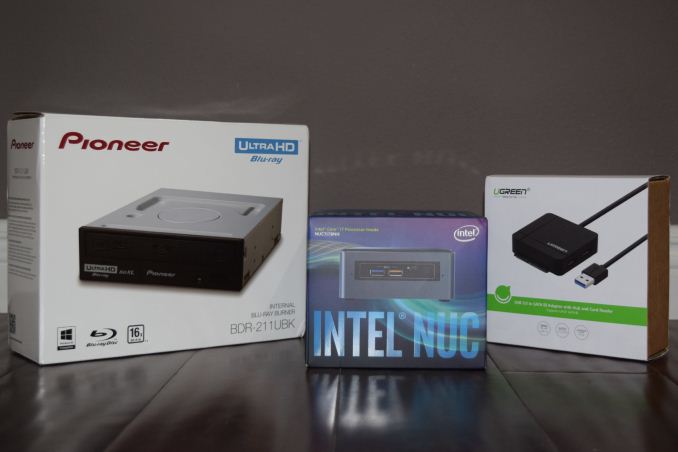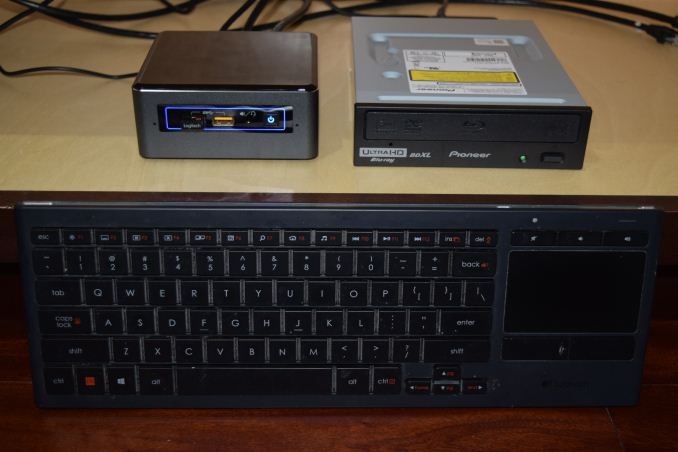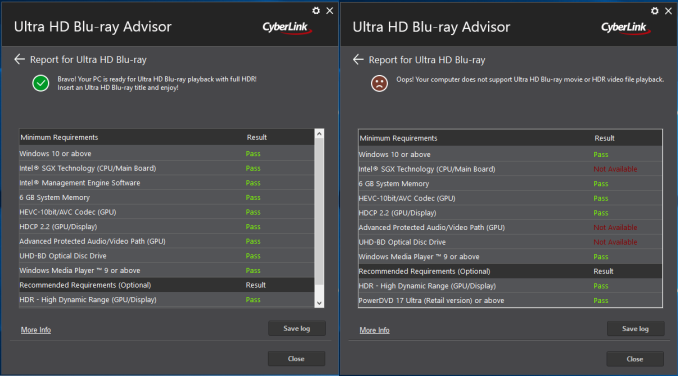A Budget Home Theater & PC Setup: 4K, HDR, UHD Blu-ray, and More
by Ganesh T S on December 26, 2017 8:30 AM ESTConfiguring a UHD Blu-ray Playback System
The rise in popularity of OTT streaming has coincided with a decline in the popularity of physical media formats such as Blu-rays. Irrespective of the market statistics, it is indisputable that the bitrates possible with the latter simply can't translated to OTT services. Bitrates usually directly correlate with video quality, though, beyond a certain point, it becomes very difficult to distinguish. HD audio formats such as Dolby Atmos, DTS-HD MA, Dolby TrueHD etc. are also yet to be widely adopted by OTT streaming services. On top of all these, Blu-rays are often treated as collectibles by some consumers.
UltraHD (UHD) Blu-rays (with their 4K resolution videos encoded in HEVC) were a bit slow to take off. On the PC front, the number of licensed software Blu-ray player vendors has come down from 3 (ArcSoft, Corel, and CyberLink) to just CyberLink alone. PowerDVD 17, with UHD Blu-ray support, was released in April 2017. The hardware requirements were quite specific, and we decided to pass up on a hands-on review at that time.
While reviewing the Intel NUC7i7BNH, I realized that it came with support for SGX, one of the primary requirements for PowerDVD 17 to play back UHD Blu-rays. I also remembered that the BIOS of the ASRock Beebox-S 7200U had a SGX option. Both of these systems also had a LSPCon on board to support HDMI 2.0 with HDCP 2.2 capability. Pioneer launched the BDR-211UBK in March, but, had specifically indicated that KBL-U was incompatible. However, based on our discussions with both CyberLink and Intel, we decided to give the drive a try by connecting the internal SATA ODD using a compact SATA-USB bridge.
The Pioneer BDR-211UBK and the UGREEN SATA-USB Adapter Combine to Make the Intel NUC7i7BNH a UHD Blu-ray Player
We looked up Amazon for a compact bridge and chanced upon a versatile UGREEN adapter. In addition to supporting the SATA drive, it also had a couple of USB 3.0 Type-A extension ports and a microSD reader. This made sure that the optical drive would not completely take over the USB port in the host system.
Using an Internal Drive without an Enclosure is not an Issue if the Setup is Tucked Out-of-Sight
After setting up the hardware and configuring the BIOS appropriately in the two systems, we installed the Management Engine components. The next step was to confirm that the system and allied components were correctly set up for UHD Blu-ray playback with HDR. CyerbLink provides the Ultra HD Blu-ray Advisor tool for this purpose. It also helpfully points out missing ME components or mis-configured BIOS options. Even though we were aware that the Zotac ZBOX MAGNUS EN1080K doesn't pass the requirements check (no SGX, iGPU inactive), we did try out the tool on it also.
The CyberLink Ultra HD Blu-ray Advisor (L: ASRock Beebox-S 7200U, R: Zotac ZBOX MAGNUS EN1080K)
Even though it is possible that the Zotac EN1080K might enable SGX in a future BIOS release, the use of the Intel GPU is probably disabled at the board level. This means that there is no protected audio/video path for secure decoding of the UHD Blu-ray streams. Given that there is no talk of UHD Blu-ray support from NVIDIA Pascal, consumers shouldn't keep their hopes up regarding the possibility of UHD Blu-rays getting played back on NVIDIA Pascal-equipped systems. Coming back to the results of the UHD BD Advisor tool, we find that the two KBL-U systems pass all the checks. We purchased a retail copy of the Planet Earth II UHD Blu-ray for testing out our setup.













191 Comments
View All Comments
Kevin G - Wednesday, December 27, 2017 - link
In the market, it seems that 4K using HDMI 2.0 with HDCP 2.2 and HDR has finally settled things down after several years of turbulence. By my count we're at the five generation of consumer 4K/UHD. First we had the wave of 4K support only via HDMI 1.4/HDCP 1.4, then a half step with some HDMI 1.4/HDCP 2.0 displays which didn't see wide spread release as a new generation with HDMI 2.0/HDCP 2.0 was around the corner which could finally do 4k60. Then HDCP 2.2 came out making all the previous HDCP 2.0 displays incredibly short lived. Now we're seeing the advent of HDR being a standardized feature to go alongside 4k. All of this is over the course of 5 years. Finally have things settle down for 4K that getting content on the display as designed is not a headache as it has been in years past. Oh and 4K content is finally arriving with streaming services and 4K disc media.The problem with HDMI 2.1 is that there will likely be three generations of hardware that support. First wave, which will likely be shown off at CES 2018, will focus around higher frame rate transfer or higher resolution. As these devices start shipping in late 2018, there will likely be a new HDCP version to protect 8K content announced to make all the new displays only worthwhile as monitors for the first save of HDMI 2.1 video cards. Hooray for copy protection screwing over the consumer! Then I see another generation of displays accepting variable refresh rate as soon as Sony or MS update their console to support variable refresh rate. Ultimately a good thing gaming but it'll spur another round of obsolete hardware. Best time to adopt would be wait until 8K media has settled own on a distribution medium as once content becomes readily available, there is less incentive to change underlaying spec. That'll still be years away.
fallaha56 - Tuesday, December 26, 2017 - link
Also...Gemini Lake cannot do HDR because of ‘power contraints’ but an iPhone or Samsung can?Really? Or is this just intel at it again
lowphas - Wednesday, December 27, 2017 - link
A <75 usd android TV box can do 4k60fps hdr decode on paper. Usually they have a 5v2a power supply. But I dunno, never had one before.Tv sets are just a display panel and a small (maybe mobile?) soc in my eyes. There is virtually no power or thermal limitation inside a tv. (I have an mu7000 series tv)
So back to the intel cpu... I am just missing some point or it is not that demanding feature so in my opinion it can be maybe a price(ing)* constrain.
Mikzip - Tuesday, December 26, 2017 - link
Is it possible to get HDR out by means of USB C to HDMI adaptor, my HDMI port is only 1.4Kevin G - Wednesday, December 27, 2017 - link
Depends on the system but most USB-C ports that can provide video do so natively by DisplayPort and then convert that over to HDMI. So HDR output is possible because DP supports it but the DP to HDMI conversion chip plays a roll here too.So the short answer is yes but it may not be possible with all adapters.
Mikzip - Wednesday, December 27, 2017 - link
Do you know of any such adapter, the only one i have been able to lokate with HDR are only for the MacBook, and my USB C port don't have ThunderboltKevin G - Wednesday, December 27, 2017 - link
Not off hand that'd be guaranteed to work. Even if an adapter doesn't immediately work, you could try editing the system's EDID table to expose 10 bit color etc. and see what gets passed through. I strongly recommend this testing with a display that accepts HDR via both DP and HDMI so you could compare the results with and with the adapter as a factor.Mikzip - Wednesday, December 27, 2017 - link
I was trying to hook it up to my HDR TV LGB6, all HDMI inputs accept HDR. Editing EDID table are a little out of my league I'm afraid ;-)harshw - Tuesday, December 26, 2017 - link
The BIOS ver for the ASRock Beebox 7200-S is shown as 1.73. The version available for download from the website is 1.60. Was the 1.73 ver also a beta?And any idea of what the LSPCon version was? 1.66?
It's sad that the Intel HD graphics cannot do YCbCr 4:2:2 ...
Nestoritwiz - Tuesday, December 26, 2017 - link
Budget??Don't get me wrong I applaud your choices any of that stuff which I would love to own and it's a combination is a whole oh my God I'd be so happy.
But if the goal was to be on a budget or last three to five years without being update outdated then why would you use a DVD player of any kind three to five years come on we all know streaming is future DVDs are like VHS. Nvidia shield on sale for 149, T5 Samsung hard drive or some equivalent hundred bucks or less, ajisen air mouse remote 25 bucks. Get your home theater system 2 to 300. And you're good to go. Thank you for allowing me to express my thoughts I just think you missed the mark a little bit.
Happy holidays
Stephen